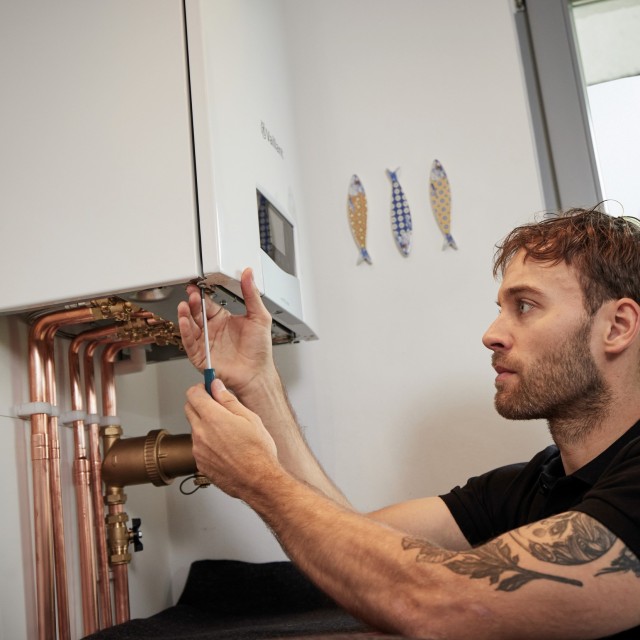Low boiler pressure is a common issue and can lead to a lack of hot water and central heating problems. Over time even the most modern boilers can become faulty and lose water pressure, eventually requiring the attention of a Gas Safe Registered engineer. Below are the steps you should take when your boiler pressure is too low.
What do I do if my boiler had no pressure?
_image_640w_213h.jpg)
How do I know if my boiler pressure is too low?
The first sign of low boiler pressure is often problems with central heating and a shortage of hot water. If you begin experiencing these issues, inspect the control panel on your boiler to find the pressure gauge. Some modern boilers will have an electronic display that shows a digital dial, while others will have a physical dial and needle.
Check the markings on the dial against the boundaries outlined in your boiler manual; often there will be two lines that show the recommended pressure levels for your system. If the gauge level or needle is below this recommended area, your boiler pressure is too low and needs to be repressurised. Typically the pressure should be around 1.5 bar when the heating system is cold.

Why is my boiler pressure low ?
Pressure is quite simply the amount of water found in the heating system. The system is made up of the boiler itself, radiators, associated pipework and other components. If your system pressure is low it simply means that there is not enough water in the system itself. This can be down to various different things typically natural loss and an escape of water, a leak.
Leaks can occur anywhere in the pipe system of a home, making them difficult to diagnose. This is particularly the case in larger homes with complex networks of pipes hidden behind walls and fixtures on multiple floors.
Fortunately, the most common place a leak occurs are at the plumbing fixtures, which are easier to spot and test. Damp spots or rust marks around radiators are often signs of leaks, as well as flaking wallpaper and bubbling skirting boards.
If you have carried out a thorough inspection of your home and have not found any signs of a leak, it may be that your boiler is faulty. Your boiler should usually show a boiler error if this is the case, but sometimes a fault can go undetected. You should call a Vaillant engineer to inspect your boiler system to find the source of the problem. Never carry out work on a boiler yourself.
How do I fix low boiler pressure?
When a boiler’s pressure is too low, the system will need to be repressurised in order to function again. You can do this yourself by operating the system filling loop. A filling loop is simply a device that is used to introduce water into the heating system and can be found somewhere on your system. In some cases these are at the appliance, in other cases they can be found elsewhere.
Different filling devices operate in different ways due to their design but fundamentally they open a tap which allows water to travel into the system pipework. Its important that this is controlled correctly so please refer to any instructions that are specific to the type of filling loop you have.
Watch the video: How to repressurise your ecoTEC plus boiler
What if I can’t repressurise my boiler?
If you have tried to repressurise your boiler but the boiler is not registering an increase in pressure, you should close the filling loop immediately and call a GSR engineer, who will be able to carry out further checks on your system. They will then either fix the issue there and then or provide a quote on a part that needs replacing, depending on the severity of the problem.
Is low boiler pressure dangerous?
Low boiler pressure is unlikely to pose a danger and is usually the result of a minor leak or fault. It is a common issue and will most probably not cause damage to your boiler, nor will impair the safety of the boiler. All modern appliances feature safety devices that will prevent the boiler from operating in any situation that could cause an issue.
Nevertheless, if your boiler pressure is too low you should address it as soon as possible to mitigate any risk of damage. A boiler can only experience so many faults until its efficiency is affected, so homeowners should look to repressurise the boiler as soon as possible.
What if my boiler pressure is too high?
If you have repressurised your boiler and the pressure is now too high, you will need to bleed your radiators to relieve some of this pressure. Bleeding a radiator involves releasing water from the pipes by slightly opening the radiator bleed valve.
Monitor the amount of water leaving the system and the level of pressure on your boiler gauge. Keep releasing pressure until the pressure level has reached the recommended amount before closing the radiator bleed valve. Your boiler should now start working again. Please note that when you bleed the radiator, it is not unusual to find air which should also be bled from any radiators.
If you have tried to bleed your radiators but the boiler pressure is still too high, call a GSR engineer to inspect your boiler system.
Summary
- Low boiler pressure is a common issue often found at the heart of domestic heating problems.
- Boiler systems have pressure gauges that show when a boiler’s pressure has become too low.
- Leaks are the most common reason for low boiler pressure, with damp spots and flaking wallpaper or paint being common hints of a leak.
- Low boiler pressure can be fixed by repressurising the boiler via the filling loop.
- High boiler pressure can be fixed by bleeding a radiator until enough water has left the system to reduce the pressure to operating levels.

